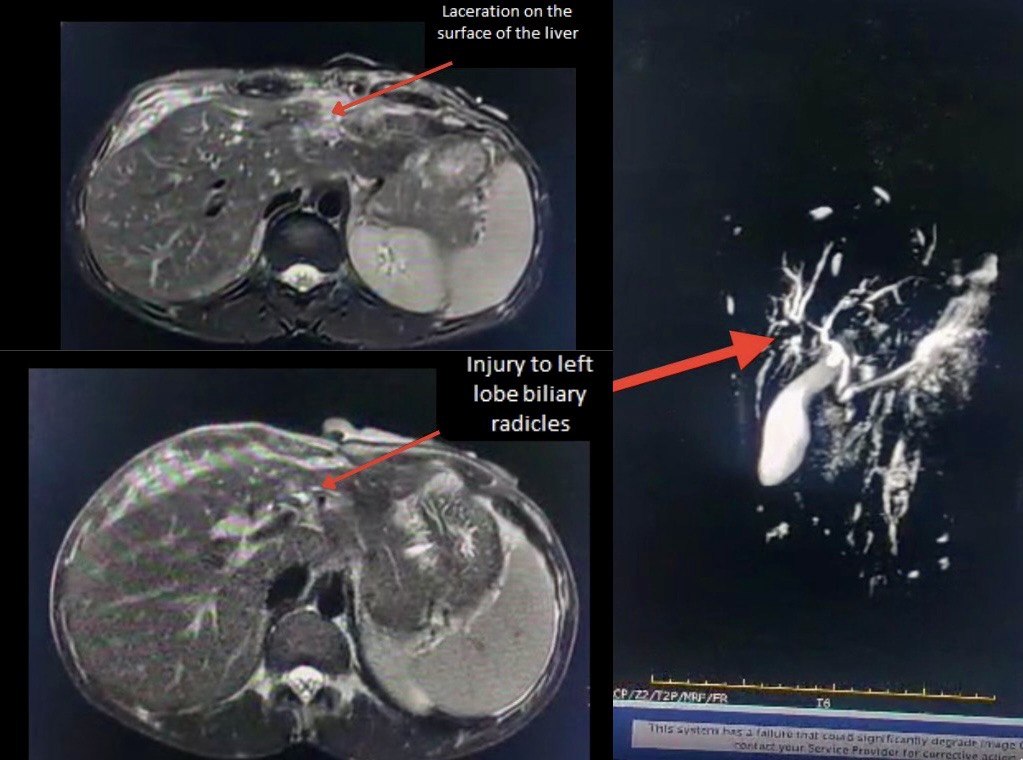Tuesday Poster Session
Category: Interventional Endoscopy
P5713 - Biliary Fistula After Hepatic Gunshot Trauma: Diagnostic and Therapeutic Role of ERCP (Endoscopic Retrograde Cholangiopancreatography )
Tuesday, October 28, 2025
10:30 AM - 4:00 PM PDT
Location: Exhibit Hall

Rayan Alataa, MD (she/her/hers)
BRONX CARE HEALTH SYSTEM
Bronx, NY
Presenting Author(s)
Rayan Alataa, MD1, Abderrahaim Ali Dabora, MD2, Hala Ibrahim, MD3, Ahmed Rafei, 2, Mohammed Ganim, MD3, Abdalla Bedab, MD3, Abdelmounem Abdo, MD3
1BRONX CARE HEALTH SYSTEM, Bronx, NY; 2Gastroenterology Associates, Kassala, Kassala, Sudan; 3Gastroenterology Consultants, Kassala, Kassala, Sudan
Introduction: Biliary leaks arise from disruptions in the biliary system, often due to iatrogenic injury, trauma, or hepatobiliary surgery. Traumatic biliary injuries are rare, accounting for only 1%–3.5% of abdominal injuries and typically result from penetrating trauma such as gunshot wounds. If untreated, bile leakage can lead to bile peritonitis, biloma, or fistula formation. Endoscopic retrograde cholangiopancreatography (ERCP) plays an essential role in both diagnostic and therapeutic benefits in managing biliary complications, yet its application in trauma cases remains underreported. This case highlights successful ERCP-based management of a post-gunshot biliary fistula in a conflict zone.
Case Description/
Methods: A 31-year-old male presented with gunshot injuries to the left hand and abdomen. Initial CT showed hepatic lacerations in segments III and IV, with subcapsular fluid accumulation and intrahepatic biliary duct dilatation. Following brachial artery repair and hepatic hemorrhage control, he exhibited bile leakage from the abdominal wall seven days postoperatively. Magnetic resonance cholangiopancreatography (MRCP) confirmed the presence of biliary fistula, a connection between the liver defect and the abdominal wall. He was referred for ERCP, during which normal ductal anatomy was observed. A sphincterotomy was performed, and an 8 Fr,10 cm biliary stent was placed in the right hepatic duct.
Subsequently, the percutaneous bile leak resolved, and the patient did not develop any signs of infection or sepsis. Six Months later, ERCP demonstrated the absence of any biliary leakage, allowing for safe removal of the stent without complications. This case illustrates the successful endoscopic management of post-traumatic biliary fistula in a complex clinical scenario, particularly in a resource-limited setting.
Discussion: Traumatic biliary injuries often present with nonspecific symptoms and can be missed intraoperatively. ERCP is the gold standard for both diagnosis and treatment of biliary leaks, with high-resolution rates through stenting and sphincterotomy. In this case, ERCP facilitated minimally invasive, effective management of a traumatic bile leak. Given the rise in penetrating injuries due to the ongoing conflict in Sudan and limited surgical resources, ERCP provides a critical nonoperative option. This case highlights the utility of ERCP in conflict-related hepatobiliary trauma and highlights the need for expanded access and research into its use in low-resource, conflict-affected settings.

Figure: CT abdomen and MRCP findings in a patient with biliary fistula following hepatic gunshot trauma.
Axial CT images (left) demonstrate a laceration on the liver surface and injury to the left lobe biliary radicles.
Coronal MRCP image (right) shows contrast extravasation from the left intrahepatic ducts, consistent with a biliary leak.
Disclosures:
Rayan Alataa indicated no relevant financial relationships.
Abderrahaim Ali Dabora indicated no relevant financial relationships.
Hala Ibrahim indicated no relevant financial relationships.
Ahmed Rafei indicated no relevant financial relationships.
Mohammed Ganim indicated no relevant financial relationships.
Abdalla Bedab indicated no relevant financial relationships.
Abdelmounem Abdo indicated no relevant financial relationships.
Rayan Alataa, MD1, Abderrahaim Ali Dabora, MD2, Hala Ibrahim, MD3, Ahmed Rafei, 2, Mohammed Ganim, MD3, Abdalla Bedab, MD3, Abdelmounem Abdo, MD3. P5713 - Biliary Fistula After Hepatic Gunshot Trauma: Diagnostic and Therapeutic Role of ERCP (Endoscopic Retrograde Cholangiopancreatography ), ACG 2025 Annual Scientific Meeting Abstracts. Phoenix, AZ: American College of Gastroenterology.
1BRONX CARE HEALTH SYSTEM, Bronx, NY; 2Gastroenterology Associates, Kassala, Kassala, Sudan; 3Gastroenterology Consultants, Kassala, Kassala, Sudan
Introduction: Biliary leaks arise from disruptions in the biliary system, often due to iatrogenic injury, trauma, or hepatobiliary surgery. Traumatic biliary injuries are rare, accounting for only 1%–3.5% of abdominal injuries and typically result from penetrating trauma such as gunshot wounds. If untreated, bile leakage can lead to bile peritonitis, biloma, or fistula formation. Endoscopic retrograde cholangiopancreatography (ERCP) plays an essential role in both diagnostic and therapeutic benefits in managing biliary complications, yet its application in trauma cases remains underreported. This case highlights successful ERCP-based management of a post-gunshot biliary fistula in a conflict zone.
Case Description/
Methods: A 31-year-old male presented with gunshot injuries to the left hand and abdomen. Initial CT showed hepatic lacerations in segments III and IV, with subcapsular fluid accumulation and intrahepatic biliary duct dilatation. Following brachial artery repair and hepatic hemorrhage control, he exhibited bile leakage from the abdominal wall seven days postoperatively. Magnetic resonance cholangiopancreatography (MRCP) confirmed the presence of biliary fistula, a connection between the liver defect and the abdominal wall. He was referred for ERCP, during which normal ductal anatomy was observed. A sphincterotomy was performed, and an 8 Fr,10 cm biliary stent was placed in the right hepatic duct.
Subsequently, the percutaneous bile leak resolved, and the patient did not develop any signs of infection or sepsis. Six Months later, ERCP demonstrated the absence of any biliary leakage, allowing for safe removal of the stent without complications. This case illustrates the successful endoscopic management of post-traumatic biliary fistula in a complex clinical scenario, particularly in a resource-limited setting.
Discussion: Traumatic biliary injuries often present with nonspecific symptoms and can be missed intraoperatively. ERCP is the gold standard for both diagnosis and treatment of biliary leaks, with high-resolution rates through stenting and sphincterotomy. In this case, ERCP facilitated minimally invasive, effective management of a traumatic bile leak. Given the rise in penetrating injuries due to the ongoing conflict in Sudan and limited surgical resources, ERCP provides a critical nonoperative option. This case highlights the utility of ERCP in conflict-related hepatobiliary trauma and highlights the need for expanded access and research into its use in low-resource, conflict-affected settings.

Figure: CT abdomen and MRCP findings in a patient with biliary fistula following hepatic gunshot trauma.
Axial CT images (left) demonstrate a laceration on the liver surface and injury to the left lobe biliary radicles.
Coronal MRCP image (right) shows contrast extravasation from the left intrahepatic ducts, consistent with a biliary leak.
Disclosures:
Rayan Alataa indicated no relevant financial relationships.
Abderrahaim Ali Dabora indicated no relevant financial relationships.
Hala Ibrahim indicated no relevant financial relationships.
Ahmed Rafei indicated no relevant financial relationships.
Mohammed Ganim indicated no relevant financial relationships.
Abdalla Bedab indicated no relevant financial relationships.
Abdelmounem Abdo indicated no relevant financial relationships.
Rayan Alataa, MD1, Abderrahaim Ali Dabora, MD2, Hala Ibrahim, MD3, Ahmed Rafei, 2, Mohammed Ganim, MD3, Abdalla Bedab, MD3, Abdelmounem Abdo, MD3. P5713 - Biliary Fistula After Hepatic Gunshot Trauma: Diagnostic and Therapeutic Role of ERCP (Endoscopic Retrograde Cholangiopancreatography ), ACG 2025 Annual Scientific Meeting Abstracts. Phoenix, AZ: American College of Gastroenterology.

